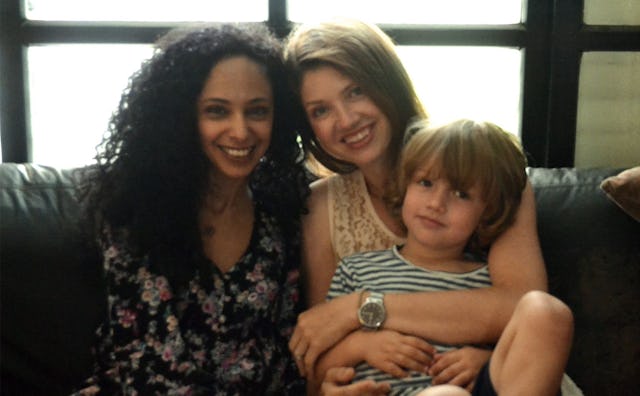What True Friendship Looks Like After Your First Child

Sometime after my childhood friend had her first child and a short while before I had mine, I realized that our phone conversations were never going to be the same (with the term “never” being used very loosely, the way a non-parent who hasn’t experienced time accelerating in front of their very eyes would). From now on it seemed like a phone conversation between us would involve me talking to my friend talking to her child, not unlike a strange love-triangle dynamic of sorts.
“Go on!” she would encourage me, hungry, as I now understand, for some grown-up interaction. “I’m just going to talk while I’m listening to you, but I am listening!” she’d say, and I would abide, walking deeper into the unfamiliar thicket of this new phase in our relationship that felt nothing like us.
Imagine a Michael Jackson “Black or White”-type slideshow with me on the left and her on the right. Pulled-back hair organically morphs into loose curls, cheekbones emerge from behind baby fat, eyeglasses give way to contact lenses to later be replaced by laser surgery. Now pull the hair back into a tired-looking bun, wash the makeup off and add some dark circles to the face on the right. Add a question mark to the eyes on the left and pause. Each one of the stages of “us” looked different and was characterized by its own dynamic, but the core of our relationship never changed. Friendship is being there for each other.
And now, here we were fumbling through our phone conversation in an attempt to redefine what “being there for each other” would look like. Experimenting with a new form of communication where I would talk into a listening ear but the reaction that followed—be it acknowledgment, validation or a follow-up question—would often be directed at someone else. It felt unnatural and disorientating, and I knew that things were exactly as they should be.
It’s a well-known fact that childbirth can put some serious strain on a couple’s bond. Isn’t it only natural to expect, then, that other meaningful relationships in our lives should also require some recalibration? The circumstances were clearly going to be different, so I should adjust my expectations and trust that she is listening. Correction: Trust that she wants to listen, and that is all that should matter at this stage.
Back to that slideshow.
Relationships can also morph.
Being there for each other used to mean calling one another on the phone whenever a New Kids video came on to make sure that the other one didn’t miss it. It used to be me writing a 12-page letter to her complete with illustrations so I wouldn’t be bored on the very first transatlantic flight I boarded by myself. It was me reassuring her that he’s a jerk and that she can do so much better. Being there for each other meant being brave enough to deliver an unpleasant verdict like, “He’s not going to call,” so your friend can move on.
(Add a giant belly to the figure on the left then subtract it.)
The definition of the new “being there for each other” is a work in progress with its borders constantly expanding to include new and unexpected forms of kindness. It turns out that being there for each other can mean responding at 4 a.m. to your distressed Facebook post published two minutes earlier to let you know that even though you may not be able to see the lights in her window on the other side of town, she is there too. It means calling you from another country to let you know she saw the post and was thinking of you. It means taking your kid to a playdate at her house so you could recover from your migraine. It means giving you a birthday gift that has nothing to do with kids, a gift that defies the idea that you can’t have nice things, because she wants you to know, because she wants to believe, that you can.
It means remembering the girl on the left.
This article was originally published on